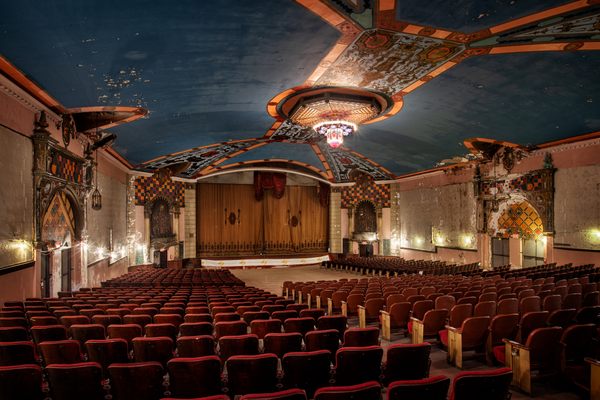An Abandoned Cinema in the Egyptian Desert Where the Only Show Is Sunset
The Sinai cinema in 2011 (photograph by Derek Cave)
Hang a left off the highway asphalt near Sharm el-Sheikh, turn away from the warm sea lapping against Egypt’s Sinai Peninsula, and head into the desert hills. Now you’re on sand packed from the wheels of a million four-wheel motorbikes — transport for tourists who may never see what you’ll see. Cross a wash of grey-brown dust, hang another left, but don’t go too far. You’ll miss the movie.
The desert, open-air cinema stretches before you with row after row of wooden seats — 700 of them — each with painted designs, rising at a reasonable rate to what looks like a projection house. Welcome to the Seventh Art Cinema. There’s no longer a movie screen, just a view onto desert hills which darken as the sun sets, the furthest hill blackening first until the rising stars light them all.
The Seventh Art Cinema could seat hundreds, but it never has. The cinema could imaginably star the place that premiered Lawrence of Arabia, but it never did. It’s not even that old. In the late 1990s, Frenchman Diynn Eadel decided to build a cinema near the southern tip of Egypt’s Sinai Peninsula, close to the growing tourist resort town of Sharm el-Sheikh, or Sharm as it’s often called. A flyer from Eadel featuring the cinema states it was his childhood dream to build such a theater in the Sinai. In France, moviemaking is called the seventh art, hence the cinema’s name.
Flyer for the cinema (courtesy Diynn Eadel)
Eadel, a former drama student and occasional actor, says he got all the necessary permits to build the theater, and told a visiting photojournalist the first show, in October 1997, would feature Jurassic Park.
“We’re very excited about this as it’s a first for the area,” Eadel said at the time, according to the South African photographer Jeremy Jowell, in his retelling of the meeting. “The seats and screen are in place and we’re looking forward to opening night.”
Yet the show never happened.
Details are sketchy as to what exactly shut the cinema down. After an Estonian photographer brought the site back into public view in 2014, Eadel stopped talking to the media about it, according to a filmmaker friend. After an initial exchange about the cinema, Eadel fell silent, neither answering questions sent directly or even through his friend.
The Sinai cinema in 2011 (photograph by Derek Cave)
While Eadel seems to consider the cinema an aborted triumph, it still drops the jaws of visitors who zoom into the cinema on their motorbikes. Derek Cave, a British tourist on a “quad-bike” tour got an impromptu visit in 2011, spurred on by his guide. Cave described the cinema’s screen as a box of steel, rusting away in the sand. The seats are still ready for theater-goers, “a few were in need a repair, but most were in working order.”
While Jowell, the South African photojournalist, bemoaned the cinema as an example of Sinai overdevelopment, Eadel seemed to see his project as a chance to add a cinematic flavor to an area already overgrowing with chain hotel and resort umbrellas along the beaches, sprouting like mushrooms. According to the cinema’s introductory flyer, Eadel with the cinema “attempts to prove that tourism is not necessarily a destructive element and that the Great Theatre of Nature can reconcile us with the elements.”
If you visit the site, you won’t see a movie, and there here aren’t any concessions. But take a moment, take an intermission, and think kindly on Eadel for the site he built that opens up not to a white screen for a movie projector, but to Sinai’s hills and a sky full of stars.
Take a seat. If you time it right, you can catch the evening show.
The cinema in the Sinai hills (via Google Maps)

















Follow us on Twitter to get the latest on the world's hidden wonders.
Like us on Facebook to get the latest on the world's hidden wonders.
Follow us on Twitter Like us on Facebook